8 Climbing Vegetables That Thrive on the Vine
Author: Jen Worst | Editor: Omar Alonso
Review & Research: Jen Worst & Chris Miller
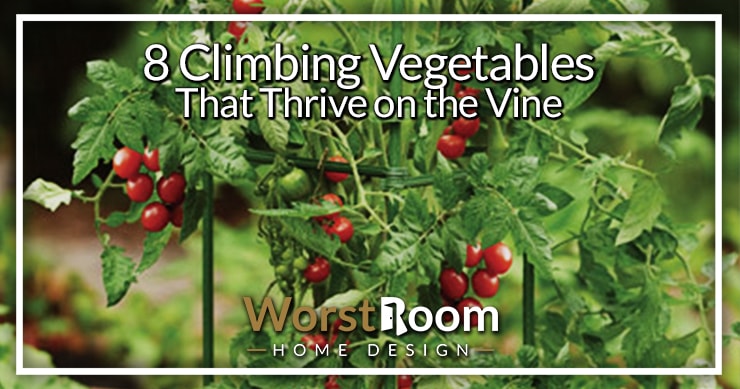
Growing climbing vegetables at home can be a healthy and cost-effective way of preparing nutritious meals at home. Vegetables are a great source of fiber and vitamins and are essential for having a balanced diet.
Nowadays, growing vegetables at home is more straightforward than most people think, even though an average citizen living in the city doesn't have much room for growing fruits or vegetables.
More often than not, people have to choose between certain plants and flowers because they simply can't fit all of them in their limited space. Climbing vegetables are an easy solution to this dilemma.
Climbing Vegetables - 8 Popular Choices
Here's our list of the best and most popular climber vegetables, or as some call them, vine vegetables.
Tomatoes

Tomatoes are the most natural vegetables to grow, especially for amateur gardeners. After the red fruit ripens, the plant looks beautiful hanging from trellis or any of the types of wire fencing.
When it comes to growing tomatoes, there are plenty of varieties to choose from. The Ailsa Graig variety is the old fashioned tomato plant, which is very pleasing to look at because of the big flowers it produces. The more common Cordon variety is the one available in stores.
Tomatoes can be supported by pots and sticks and can grow up to be tall plants. As the tomatoes grow, the plants will require additional and more reliable support; otherwise, the large ripe tomatoes will weigh the stalks down.
Cucumber

The cool green slices of a cucumber or a glass of cucumber water can be refreshing on a hot summer day. Cucumbers are an excellent vegetable plant to grow at home. They can be cultivated quickly on a trellis or lattice, which will protect them from pests and make harvesting very convenient!
It is recommended to harvest cucumbers on a daily basis; otherwise, the plant may become too heave and begin to sag. Cucumbers stop fruiting if there are too many of them already hanging from the vines.
Harvest them, slice them, and store them in the fridge for quick use. We've talked about how to keep sliced cucumbers fresh so you can enjoy them on salads, in drinks, or as a healthy snack throughout the day.
Green Beans

Green beans are one of the most natural vegetable plants to grow. They are slim and can be easily picked out when soft and tender. If beans are left to hang for too long, they become rigid, dry, and stingy. So it is better to remove them soon.
Snow Peas
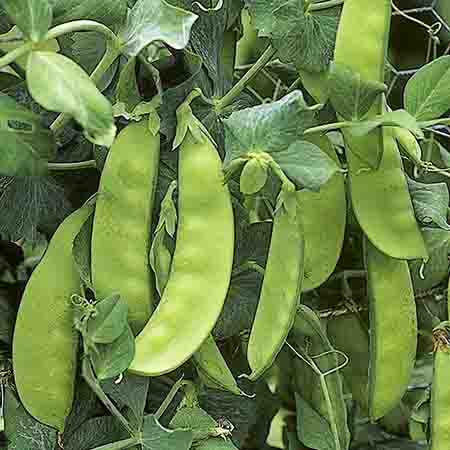
Gardening is not just for hot summer days and sunny places. Snow peas are frost resistant and grow a bunch of vegetables. Snow peas are easy to grow and can be very conveniently grown on trellis and wires.
Bitter Melon
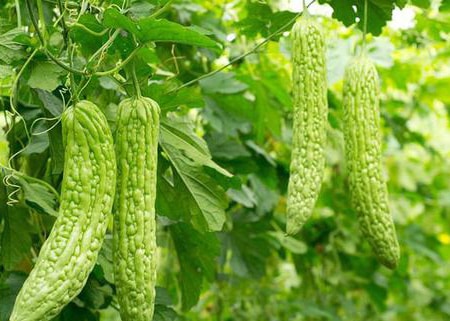
As the name suggests, Bitter melons are very bitter, but they are a rich source of antioxidants. A number of recipes mix these with soups and gravies. Bitter types of melons are similar to cucumbers and melons, but each plant produces about 10 – 12 bitter melons, each around eight inches long.
Bitter melons need hot and moist weather for ideal growth. So they are most suitable for tropical and subtropical areas. These climbing vegetable plants are easy to take care of and can grow comfortably on pergolas and trellis.
Gourd
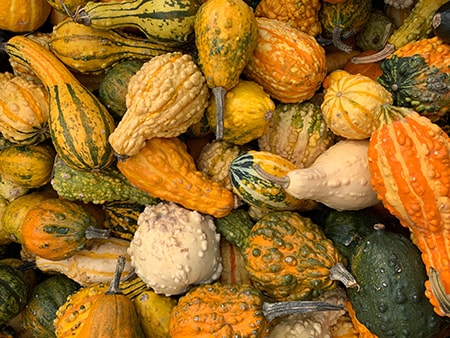
Gourds are bulky and white and are grown in warm areas. They hang steadily from vines that can grow up to forty feet long. This particular climbing vegetable may require some attention, especially the vines.
It's recommended that the vines should be cut or trimmed when they become around ten inches long, so the vegetable plant fans out appropriately.
Not only do gourds require attention, but also patience. This is because these veggies can take up to six to eight months to ripen.
Pumpkin

It might be surprising to find pumpkins on this list. After all, pumpkins with their big fan-like leaves and bulky fruits are not seen hanging from vines or branches every day.
That would be a somewhat rare sight. Nevertheless, small pumpkins can be grown in vertical gardens – they just need a hammock made of scraps of cloth to rest on.
This way, the plant will be able to hold the pumpkins, so they do not weigh the stalks down or fall. The vines of pumpkin plants should be trimmed when they reach around ten inches, so they remain manageable.
Chayote

At first glance, chayote may seem like a pear with horns, but as far as taste and texture go, chayote can't be much different from a pear. When it is cooked or boiled, it tastes like a marrow.
This little pear-like climbing vegetable is an excellent choice for a vegetable garden. This is because only one plant needs to be planted as each chayote plant can produce up to 50 chayotes.
In some areas, chayotes are also referred to as “choko” or “mirliton squash.” It is recommended to pick the chayotes a little early while soft; otherwise, they can toughen up and be a hassle to harvest.
Support for the Climbing Vegetables
While it is true that climbing vegetables grow vertically, they do not grow straight up like a tree. In most cases, some form of support is required.
In this regard, there are a number of options available, but the support chosen should be strong enough to allow the climbing vegetables to grow comfortably.
Supports come in the form of pergolas, trellises, cages, sticks, poles, and boards. A gardening shop should have all of these options available. The kind of support required depends entirely on the climbing vegetable in question.
Cucumbers, for example, grow well with A-frame support. This way, the cucumbers can hang vertically down while the plant grows up. As a result, more extended and cleaner cucumbers are produced.
Tomatoes require some training, so they grow aesthetically in any garden. The most effective support for tomatoes comes from cages.
Depending on the strain of tomatoes being grown, large or small coops can be used. The cages have to be supported by tying them to stakes sunk a few inches deep into the ground. This prevents the cages from leaning over to one side.
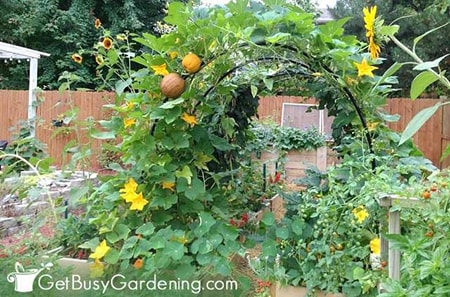
Climbing vegetable plants growing bulky fruits like melons will require support in the form of slings or hammocks. This prevents the melons from falling off the stalk prematurely.
Pergolas can make any garden look fancy. Vines growing around and over pergolas are very pleasing to look at and to sit under. Pergolas are of many types and shapes.
They can be made from a number of materials such as wood or metal. Unless the pergola is galvanized, it is advisable to buy powder coated ones.
These are the best because they can resist dramatic weather conditions without compromising the garden's look or the support for the vegetables.
Trellises are another great source of support. They provide a framework of wood or metal strips, generally crisscrossed over each other, to support the climbing vegetable.
Trellises usually lean against a wall or fence. Wooden trellises are better as metal ones can heat up dangerously over the summer. This may cause fragile plants to suffer.
Although all of these gardening accessories can be found in a decent gardening shop, it is unnecessary to buy them. A few household objects, such as an old patio umbrella, can also substitute here and offer equally good support.
Why Should You Opt For Climbing Vegetables
As the name suggests, climbing vegetables are vegetables that can grow vertically by climbing up a wall, stick, or pergola. This ability makes these vegetables a good option for gardening in limited spaces because they take up less space.
This also means that you can grow more vegetables and have more exceptional produce. Another advantage of climbing vegetables is that they're easy to incorporate with other plants.
After all, when vegetables are growing towards the sky, there is more space left on your types of hedges for flowers. The fact that climbing vegetables grow vertically protects them from a lot of soil-related problems, too.
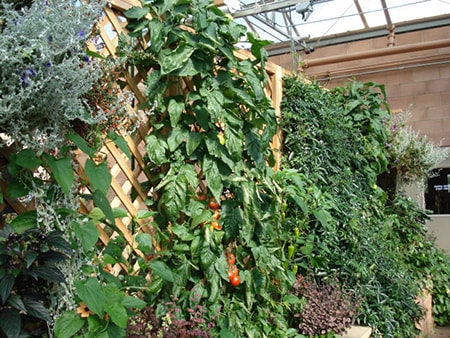
One obvious benefit is that the vegetables are cleaner; they're not buried under dirt, manure, or other fertilizer. By growing on pergolas, a wattle fence, or trellis, the vegetables are protected from being trampled upon by accident or otherwise.
Gardening becomes more flexible with climbing vegetables. Now it's unnecessary to own a house with a big backyard to grow vegetables for personal use. Climbing vegetables will grow just as well in a small terrace or a narrow balcony.
Lastly, climbing vegetables can make any garden very aesthetically pleasing to the lookout. They can add a unique and endearing appearance to any outdoor place.
It can be soothing to sit under a pergola with vines hanging off the edges, and in the current Instagram era, climbing vegetables can provide beautiful backgrounds for any photoshoot.
Now that it's clear why these are an excellent option to choose when gardening at home let us look at some common climbing vegetables that are easy to grow.
Climbing Vegetables are for Everyone!
No matter where you live or how much space you have in a yard (if you even have one in a big city), you can still grow any of the vegetables from the list above on a patio or even indoors. All of these can be potted with a stake for the vines to climb.
Don't let your lack of space stop you from enjoying gardening. It's completely enjoyable and something humans have done since the dawn of time. And now with climbing vegetables, anyone can be a gardener again.



